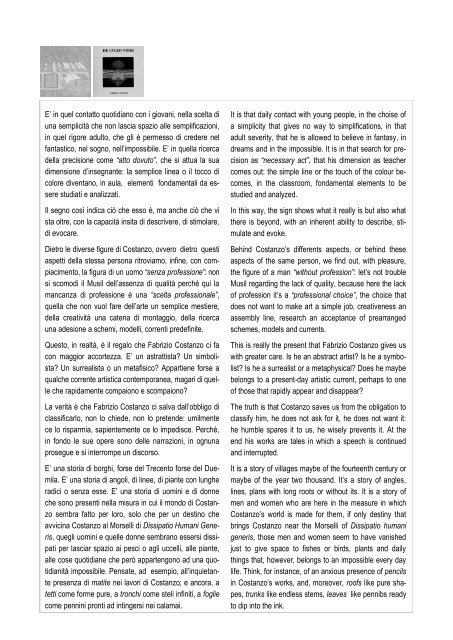Create successful ePaper yourself
Turn your PDF publications into a flip-book with our unique Google optimized e-Paper software.
Graffiti<br />
Graffiti Art<br />
E’ in quel contatto quotidiano con i giovani, nella scelta di<br />
una semplicità che non lascia spazio alle semplificazioni,<br />
in quel rigore adulto, che gli è permesso di credere nel<br />
fantastico, nel sogno, nell’impossibile. E’ in quella ricerca<br />
della precisione come “atto dovuto”, che si attua la sua<br />
dimensione d’insegnante: la semplice linea o il tocco di<br />
colore diventano, in aula, elementi fondamentali da essere<br />
studiati e analizzati.<br />
Il segno così indica ciò che esso è, ma anche ciò che vi<br />
sta oltre, con la capacità insita di descrivere, di stimolare,<br />
di evocare.<br />
Dietro le diverse figure di Costanzo, ovvero dietro questi<br />
aspetti della stessa persona ritroviamo, infine, con compiacimento,<br />
la figura di un uomo “senza professione”: non<br />
si scomodi il Musil dell’assenza di qualità perché qui la<br />
mancanza di professione è una “scelta professionale”,<br />
quella che non vuol fare dell’arte un semplice mestiere,<br />
della creatività una catena di montaggio, della ricerca<br />
una adesione a schemi, modelli, correnti predefinite.<br />
Questo, in realtà, è il regalo che Fabrizio Costanzo ci fa<br />
con maggior accortezza. E’ un astrattista? Un simbolista?<br />
Un surrealista o un metafisico? Appartiene forse a<br />
qualche corrente artistica contemporanea, magari di quelle<br />
che rapidamente compaiono e scompaiono?<br />
La verità è che Fabrizio Costanzo ci salva dall’obbligo di<br />
classificarlo, non lo chiede, non lo pretende: umilmente<br />
ce lo risparmia, sapientemente ce lo impedisce. Perché,<br />
in fondo le sue opere sono delle narrazioni, in ognuna<br />
prosegue e si interrompe un discorso.<br />
E’ una storia di borghi, forse del Trecento forse del Duemila.<br />
E’ una storia di angoli, di linee, di piante con lunghe<br />
radici o senza esse. E’ una storia di uomini e di donne<br />
che sono presenti nella misura in cui il mondo di Costanzo<br />
sembra fatto per loro, solo che per un destino che<br />
avvicina Costanzo al Morselli di Dissipatio Humani Generis,<br />
quegli uomini e quelle donne sembrano essersi dissipati<br />
per lasciar spazio ai pesci o agli uccelli, alle piante,<br />
alle cose quotidiane che però appartengono ad una quotidianità<br />
impossibile. Pensate, ad esempio, all’inquietante<br />
presenza di matite nei lavori di Costanzo; e ancora, a<br />
tetti come forme pure, a tronchi come steli infiniti, a foglie<br />
come pennini pronti ad intingersi nei calamai.<br />
It is that daily contact with young people, in the choise of<br />
a simplicity that gives no way to simplifications, in that<br />
adult severity, that he is allowed to believe in fantasy, in<br />
dreams and in the impossible. It is in that search for precision<br />
as “necessary act”, that his dimension as teacher<br />
comes out: the simple line or the touch of the colour becomes,<br />
in the classroom, fondamental elements to be<br />
studied and analyzed.<br />
In this way, the sign shows what it really is but also what<br />
there is beyond, with an inherent ability to describe, stimulate<br />
and evoke.<br />
Behind Costanzo’s differents aspects, or behind these<br />
aspects of the same person, we find out, with pleasure,<br />
the figure of a man “without profession”: let’s not trouble<br />
Musil regarding the lack of quality, because here the lack<br />
of profession it’s a “professional choice”, the choice that<br />
does not want to make art a simple job, creativeness an<br />
assembly line, research an acceptance of prearranged<br />
schemes, models and currents.<br />
This is really the present that Fabrizio Costanzo gives us<br />
with greater care. Is he an abstract artist? Is he a symbolist?<br />
Is he a surrealist or a metaphysical? Does he maybe<br />
belongs to a present-day artistic current, perhaps to one<br />
of those that rapidly appear and disappear?<br />
The truth is that Costanzo saves us from the obligation to<br />
classify him, he does not ask for it, he does not want it:<br />
he humble spares it to us, he wisely prevents it. At the<br />
end his works are tales in which a speech is continued<br />
and interrupted.<br />
It is a story of villages maybe of the fourteenth century or<br />
maybe of the year two thousand. It’s a story of angles,<br />
lines, plans with long roots or without its. It is a story of<br />
men and women who are here in the measure in which<br />
Costanzo’s world is made for them, if only destiny that<br />
brings Costanzo near the Morselli of Dissipatio humani<br />
generis, those men and women seem to have vanished<br />
just to give space to fishes or birds, plants and daily<br />
things that, however, belongs to an impossible every day<br />
life. Think, for instance, of an anxious presence of pencils<br />
in Costanzo’s works, and, moreover, roofs like pure shapes,<br />
trunks like endless stems, leaves like pennibs ready<br />
to dip into the ink.


